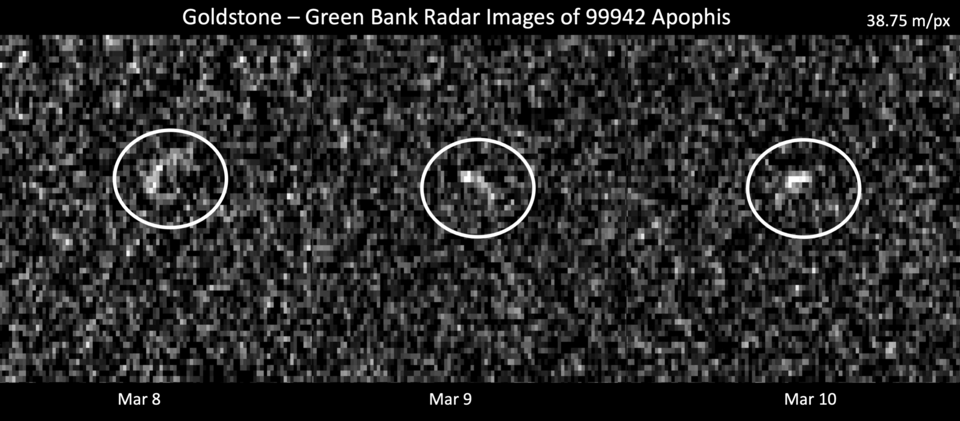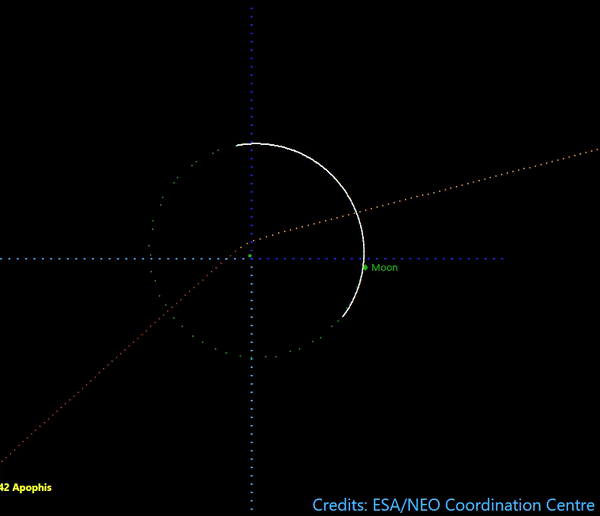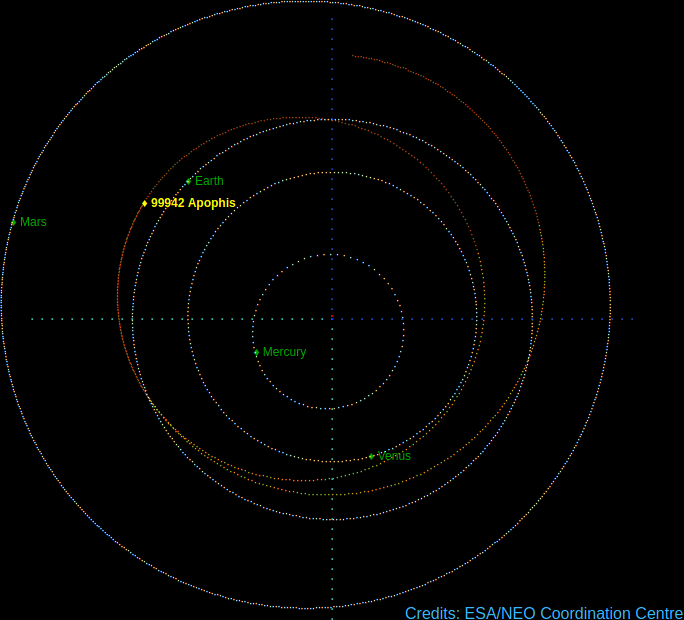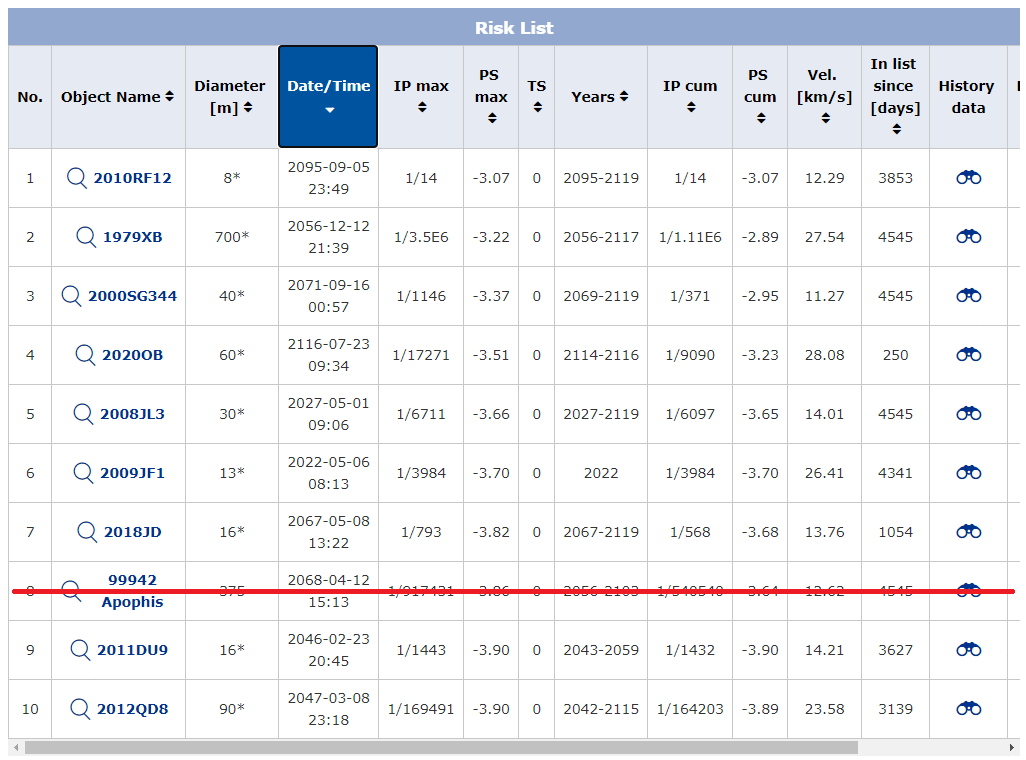New observations of asteroid Apophis – thought to pose a slight risk of impacting Earth in 2068 – rule out any chance of impact for at least a century. After 17 years of observations and orbit analysis, ESA is removing the enormous asteroid from its Risk List.
Estimated at about 350 m across – equivalent to the length of three football fields – Apophis has been in and out of the headlines for years as astronomers have tried to pinpoint its precise orbit and the possibility of any future impact.
Soon after its detection in 2004, astronomers predicted two impact possibilities in 2029 and 2036, but additional observations of the near-Earth object (NEO) thankfully ruled these out. Until now, a small but concerning chance of impact in 2068 remained.
Recent radar measurements rule out impact

New radar observations of Apophis were taken in early March by NASA’s Goldstone Deep Space Communications Complex in California and the Green Bank Observatory, West Virginia. They have provided enough data on the orbit of the infamous asteroid to finally rule out, with certainty, any Earth impact for at least 100 years.
These latest observations were possible as the asteroid made a not-so-close approach on 6 March, passing by Earth at a distance of roughly 17 million km (44 times the distance to the Moon). Although the asteroid was still reasonably far away, astronomers could precisely measure its distance and refine its orbit before its next, very close approach in 2029.
Apophis through the keyhole
We know the position and orbit of the planets with quite some precision, but for smaller objects like asteroids there is always some uncertainty in their trajectories. To make things more complicated, as asteroids pass by massive objects with huge gravitational forces, their path is altered and this uncertainty in their trajectory is amplified.
Before the latest radar measurements of Apophis were taken, its orbit was understood with enough accuracy to predict a series of safe close approaches over the coming decades.

The next and closest of these swing-bys will take place on Friday, 13 April 2029, when Apophis will pass less than 35 000 km from Earth and be visible to the naked eye. At ten times closer than the Moon, Apophis will be closer than satellites orbiting in the Geostationary ring.
At this distance, Earth’s gravity will have a notable impact on the passing space rock, altering its path and amplifying the uncertainty in its orbit and in possible future impacts.
What was not known previously is whether the 2029 flyby would alter Apophis’ orbit in just the ‘right’ way that it would collide with Earth in a future orbit around the Sun. To do this, Apophis would pass through what’s called a ‘gravitational keyhole’, leading to a potential (but still very unlikely) impact in 2068.

“With the support of recent optical observations and radar observations, the uncertainty in Apophis’ orbit has collapsed from hundreds of kilometres to just a handful of kilometres when projected to 2029,” explains Davide Farnocchia of NASA’s Center for Near Earth Object Studies (CNEOS).
Fortunately, these latest radar observations have reduced the uncertainty in Apophis’ trajectory to such an extent that even with the orbit-altering effects of the upcoming 2029 flyby, any chance of impact in 2068 or long after has been ruled out.
Apophis is removed from the Risk List
ESA’s asteroid Risk List is a catalogue of all near-Earth objects that have a ‘non-zero’ chance of impacting Earth. This means however unlikely an object’s chance of impact, anything greater than zero remains on the list.

Asteroid experts at the Agency’s Near-Earth Object Coordination Centre (NEOCC) then spend a lot of time getting to know these objects – obtaining new follow-up observations and using data from observatories around the globe to better understand their orbit and calculate their impact probability over the next 100 years.
More observations lead to better understanding and certainty of an asteroid’s movements. When the team is certain an asteroid poses no threat to Earth, they remove it from the list.
Apophis has been a special case, remaining stubbornly on the Risk List for almost 17 years. Because of its large size, it has understandably drawn much attention and at points in its history, concern.
"The discovery of Apophis and early work done to track and understand its orbit, occurred when today's Planetary Defence activities were still in their infancy,” explains Juan Luis Cano from ESA’s Near-Earth Object Coordination Centre.
“That this happened at such an early period in the discipline served as strong motivation to improve our capabilities to accurately predict the motion of these interesting and potentially dangerous objects. With today's removal of Apophis from the Risk List, we are closing a very enlightening chapter in the history of Planetary Defence".
Tags: Observatory
